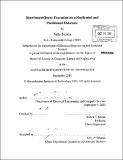Distributed query execution on a replicated and partitioned database
Author(s)
Narula, Neha
DownloadFull printable version (3.135Mb)
Other Contributors
Massachusetts Institute of Technology. Dept. of Electrical Engineering and Computer Science.
Advisor
Robert T. Morris.
Terms of use
Metadata
Show full item recordAbstract
Web application developers partition and replicate their data amongst a set of SQL databases to achieve higher throughput. Given multiple copies of tables partioned different ways, developers must manually select different replicas in their application code. This work presents Dixie, a query planner and executor which automatically executes queries over replicas of partitioned data stored in a set of relational databases, and optimizes for high throughput. The challenge in choosing a good query plan lies in predicting query cost, which Dixie does by balancing row retrieval costs with the overhead of contacting many servers to execute a query. For web workloads, per-query overhead in the servers is a large part of the overall cost of execution. Dixie's cost calculation tends to minimize the number of servers used to satisfy a query, which is essential for minimizing this query overhead and obtaining high throughput; this is in direct contrast to optimizers over large data sets that try to maximize parallelism by parallelizing the execution of a query over all the servers. Dixie automatically takes advantage of the addition or removal of replicas without requiring changes in the application code. We show that Dixie sometimes chooses plans that existing parallel database query optimizers might not consider. For certain queries, Dixie chooses a plan that gives a 2.3x improvement in overall system throughput over a plan which does not take into account perserver query overhead costs. Using table replicas, Dixie provides a throughput improvement of 35% over a naive execution without replicas on an artificial workload generated by Pinax, an open source social web site.
Description
Thesis (S.M.)--Massachusetts Institute of Technology, Dept. of Electrical Engineering and Computer Science, 2010. Cataloged from PDF version of thesis. Includes bibliographical references (p. 63-64).
Date issued
2010Department
Massachusetts Institute of Technology. Department of Electrical Engineering and Computer SciencePublisher
Massachusetts Institute of Technology
Keywords
Electrical Engineering and Computer Science.